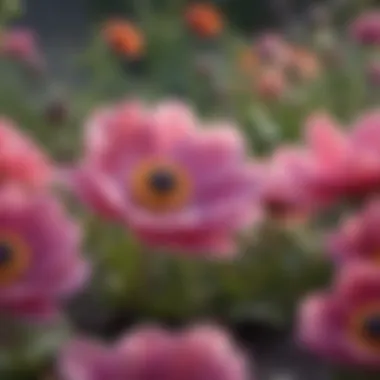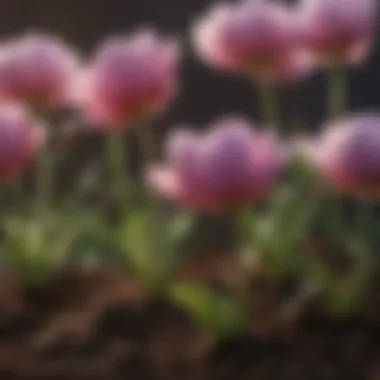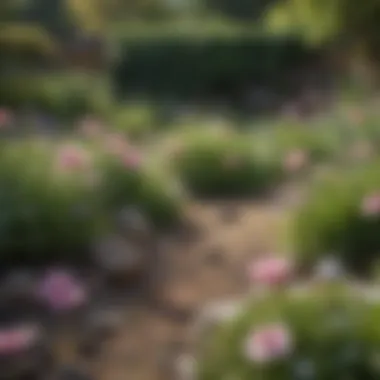Understanding Anemone de Caen Bulbs: A Complete Guide


Intro
Anemone de Caen bulbs, known for their vibrant colors and delicate petals, are a popular choice among gardeners and landscape designers alike. Understanding their unique characteristics and cultivation requirements is essential for harnessing their full potential in any garden setting. This comprehensive guide will explore various aspects of these bulbs, providing valuable insights for both novice and experienced horticulturists.
Characteristics of Anemone de Caen Bulbs
Anemone de Caen bulbs are perennials that belong to the buttercup family. The plant is characterized by its feathery foliage and stunning flowers that bloom in various shades, including blue, purple, pink, and white. Typically, these bulbs are planted in spring or fall, allowing them to flourish as temperatures rise.
Planting Techniques
Correct planting is crucial to ensure successful growth. It is advisable to plant Anemone de Caen bulbs in well-draining soil with access to partial sunlight. Spacing each bulb about six inches apart will prevent overcrowding, which can lead to poor air circulation and disease susceptibility.
Care and Maintenance
Regular maintenance is important to keep Anemone de Caen healthy. This includes watering, which should be done when the top inch of soil feels dry. Fertilizing with a balanced fertilizer can also aid in blooming. After the flowering period, it is essential to allow the foliage to die back naturally, as this process helps the bulb store energy for future growth.
Pest and Disease Management
Despite their beauty, Anemone de Caen bulbs can attract pests such as aphids and slugs. To manage these issues, it is important to conduct regular inspections. Protective measures include using insecticidal soap or introducing beneficial insects. Diseases like root rot can occur due to excessive moisture; therefore, proper drainage is fundamental.
“Understanding the lifecycle and care of Anemone de Caen bulbs can enhance both aesthetic appreciation and horticultural success.”
Aesthetic Value
Incorporating Anemone de Caen bulbs into landscaping designs brings a splash of color and softness. They pair well with other spring bloomers, creating a vibrant mosaic of flowers. Their low growing habit makes them suitable for borders, rock gardens, or even in pots for a more compact display. With proper care, these bulbs can provide a stunning visual element to gardens.
End
Preamble to Anemone de Caen Bulbs
Anemone de Caen bulbs are a compelling choice for any gardener looking to infuse their space with vibrant color. This section outlines the significant aspects of these bulbs. Understanding their characteristics and requirements can lead to successful cultivation and beautiful results. For tose interested in horticulture, Anemone de Caen provides both an aesthetic appeal and a manageable approach to gardening.
Overview of the Anemone de Caen
Anemone de Caen, belonging to the Ranunculaceae family, offers a unique charm due to its various color options and relatively easy care requirements. These perennials bloom from late spring to early summer, producing open cup-shaped flowers. Respectively, the blooms range in color from white to deep purple. They can elevate any garden design due to their striking presence and versatility.
One of the appealing characteristics of Anemone de Caen is its ability to adapt to different environments. They thrive in different soil types and can be planted in various regions. By understanding how to properly plant and care for these bulbs, even novice gardeners can enjoy their beauty without facing significant challenges.
Historical Significance
The history of Anemone de Caen is intriguing and goes back many years. Emerging from natural habitats in the Mediterranean region, they cultivated during the 19th century. They quickly gained popularity among garden enthusiasts for their unique appearance and relatively easy growth habits.
Important botanical expeditions contributed to their introduction to different markets. Anemones became symbols of beauty, fragile yet resilient, representing various cultural significances throughout time. Their popularity spread, making them a staple in gardens worldwide, demonstrating the lasting influence of Anemone de Caen in botanical gardens and private landscapes alike.
Anemone de Caen’s rich history and adaptability make them significant in horticulture, serving both aesthetic and educational purposes in gardening practices.


Botanical Characteristics
Botanical characteristics of Anemone de Caen bulbs are vital to understanding how to cultivate and care for them effectively. These elements influence their growth patterns, aesthetic appeal, and suitable environments for cultivation. By comprehending these traits, gardeners can make informed decisions that enhance the beauty of their landscapes.
Physical Attributes
Leaf Structure
The leaf structure of Anemone de Caen is noteworthy for its finely divided, fern-like appearance. This unique feature allows for effective photosynthesis while providing a delicate backdrop for the vibrant blooms. The leaves typically grow on long stems that emerge from the bulbs, adding height and grace to the garden. One significant advantage of this leaf structure is its ability to remain attractive even after the flowering period has ended. However, the fragile nature of the leaves can make them susceptible to damage from harsh weather or heavy foot traffic.
Flower Design
Anemone de Caen flowers present a striking design that captures attention. The blooms are cup-shaped, featuring overlapping petals that create an elegant silhouette. This flower design is advantageous, as it not only adds a bold visual impact but also attracts a variety of pollinators, enhancing ecosystem health. The key characteristic of these flowers is their ability to remain open during cloudy days, providing a continuous display of color. Nevertheless, their delicate petals may be prone to wilting in extreme heat or heavy rain, necessitating care in placement.
Color Variations
The color variations of Anemone de Caen bulbs are one of their most compelling features. Available in hues ranging from deep purple to bright red, these colors can significantly enhance any garden's aesthetic. This diversity allows gardeners to create striking color schemes or combinations within their planted areas. The ability to blend different colors also makes these bulbs popular for seasonal displays. However, certain color shades can fade over time or appear differently based on soil conditions and light exposure, which is an essential consideration for potential growers.
Growing Zones
Understanding growing zones is critical for the successful cultivation of Anemone de Caen bulbs. These bulbs thrive in USDA hardiness zones 6 to 9. This range provides the ideal climate to support their growth cycles and flowering periods. Planting outside these zones may lead to disappointing results, as the bulbs may struggle to establish themselves or even survive. Therefore, before planting, it is advisable to check your local growing zone to ensure a healthy and fruitful gardening experience.
Cultivation Techniques
Cultivation techniques are crucial for successfully growing Anemone de Caen bulbs. Understanding these techniques is essential for optimizing their growth and ensuring vibrant blooms. Proper methods can significantly enhance the flowering potential and overall health of the plants, making them a valuable addition to any garden.
Ideal Soil Conditions
Anemone de Caen bulbs thrive in well-drained soils rich in organic matter. The ideal soil should be loamy or sandy with a pH level between 6.0 and 7.0. This type of soil ensures that moisture does not accumulate around the bulbs, which can lead to rot. Incorporating compost or well-rotted manure can improve soil structure as well as fertility.
To prepare the soil:
- Test pH levels to ensure they are suitable for growth.
- Turn the soil to a depth of at least 12 inches to promote aeration.
- Add organic matter to enrich the soil either before or during planting.
In cooler climates, consider mulching to provide additional insulation during winter.
Planting Instructions
Planting Anemone de Caen bulbs requires attention to depth and spacing. These bulbs should be planted in early spring or late autumn for optimal growth. Ensure the soil is dry enough to avoid water-logging.
The planting process involves:
- Choosing a location with full to partial sunlight.
- Digging holes approximately 2 to 3 inches deep, with a spacing of about 6 inches between bulbs.
- Placing the bulbs in the holes with the pointed end facing upwards.
- Covering with soil and lightly pressing down to eliminate air pockets.
- Watering gently after planting to help settle the soil.
Following these steps closely can improve the bulb's chances of successful sprouting.


Watering Requirements
Watering is a critical part of maintaining Anemone de Caen bulbs. These plants prefer moderate moisture levels. It is vital to keep the soil moist but not soggy. Overwatering can lead to bulb rot, while underwatering can affect growth and blooming.
Here are some practical tips for watering:
- Water thoroughly after planting to set the bulbs in place.
- Monitor rainfall during the growing season and adjust your watering schedule accordingly.
- Use a soaker hose to provide consistent moisture without saturating the surface of the soil.
During dry spells, additional watering may be necessary, but avoid doing so just before winter dormancy to prevent rot.
Proper cultivation techniques lead to healthy Anemone de Caen bulbs, ensuring that they bring a splash of color and beauty to your garden.
Maintenance and Care
Maintaining Anemone de Caen bulbs is critical for their growth and longevity. Proper care can result in vibrant blooms and a healthy garden. Investing time in maintenance ensures that these bulbs thrive under optimal conditions. Attention to detail in care practices not only promotes plant health but also enhances the overall garden aesthetic.
Fertilization Tips
Fertilization plays a fundamental role in the growth of Anemone de Caen bulbs. A balanced approach can lead to lush foliage and abundant flowers. Here are key points to consider:
- Use a Low-Nitrogen Fertilizer: Select a fertilizer with a balanced N-P-K ratio. A formulation like 5-10-10 may be beneficial, as it encourages flowering over leafy growth.
- Timing: Apply fertilizer at the start of the growing season. This time ensures that nutrients are available when the plants need them most.
- Frequency: Fertilize every four to six weeks during the growing season. Be cautious not to over-fertilize, which can lead to burned roots or excessive foliage.
Pruning Best Practices
Pruning is an essential aspect of Anemone de Caen bulb care. Proper pruning techniques help improve air circulation and plant vitality. Consider these practices:
- Deadheading: Remove spent blooms promptly. This practice promotes further blooming and prevents the plant from expending energy on seed production.
- Foliage Care: After flowering, allow the foliage to die back naturally. This process supports bulb energy storage for the next season.
- Seasonal Trim: In the fall, tidy the garden by removing any dead leaves and debris. This maintenance helps to prevent pests and diseases.
Post-Bloom Care
After the blooms have faded, how you care for Anemone de Caen bulbs can dictate their performance in the following years. Here are some considerations for post-bloom care:
- Watering: Gradually reduce watering after blooming to allow the bulbs to enter dormancy. This method prevents rot and helps with bulb health.
- Mulching: Apply a layer of mulch to retain moisture and regulate soil temperature. Organic mulch is preferred as it adds nutrients back to the soil as it breaks down.
- Storage: If you live in a region with cold winters, dig up the bulbs in late fall. Store them in a dry, cool place until replanting in the spring.
By following these maintenance and care strategies, your Anemone de Caen bulbs can flourish and bring beauty to your landscape year after year.
Pests and Diseases
Pests and diseases pose significant challenges to the cultivation of Anemone de Caen bulbs. Understanding how these threats affect growth and development is crucial for gardeners aiming to achieve vibrant blooms. As with many plants, the health of Anemone de Caen is directly linked to environmental factors, pest infestations, and disease outbreaks. Without proper management, serious problems can arise that diminish not only aesthetic appeal but also overall plant vitality and longevity.
Common Pests
Anemone de Caen can fall victim to various pests that threaten their growth. Common pests include:
- Aphids: These small insects feed on sap and can deform leaves. They may also transmit viruses.
- Spider Mites: These tiny arachnids create webs and suck juices from plants, leading to discoloration.
- Slugs and Snails: These mollusks tend to eat tender leaves and flowers, resulting in unsightly holes.
- Thrips: These minuscule insects cause stippling on leaves and can lead to flower malformation.


Managing these pests promptly is essential to prevent any long-term damage.
Preventive Measures
Taking proactive measures is the best strategy for preventing pest infestations. Consider these tips:
- Soil Health: Healthy soil results in strong plants. Regularly amend soil with organic matter to promote vigor.
- Proper Spacing: Avoid overcrowding, as it fosters conditions favorable for pests.
- Regular Inspections: Examine plants weekly for early signs of pests to catch infestations before they escalate.
- Natural Predators: Encourage beneficial insects, like ladybugs, that can naturally control aphid populations.
- Mulching: Use organic mulch to deter slugs and snails from reaching plants.
Implementing these strategies will create a favorable environment for the Anemone de Caen.
Treatment Options
If pests are detected, immediate action is needed to minimize damage. Some effective treatment options include:
- Insecticidal Soap: This treatment can effectively manage soft-bodied pests like aphids and thrips.
- Neem Oil: An organic solution, neem oil helps disrupt the life cycle of many garden pests.
- Handpicking: For slugs and snails, physically removing them can be quite effective.
- Row Covers: These can physically block pests from reaching plants while still allowing light and moisture.
Combining treatments often yields the best results for healthier blooms. By addressing pests and diseases promptly, gardeners can ensure their Anemone de Caen thrives beautifully.
Landscape Design Applications
The application of Anemone de Caen bulbs in landscape design is significant for several reasons. First, these bulbs provide vibrant colors that can enhance the aesthetic appeal of any garden or outdoor space. Their unique flower shapes and range of colors can create focal points in landscape designs, drawing attention and guiding the viewer's eye throughout the garden.
Another important aspect is their versatility. Anemone de Caen bulbs can be used in various settings, from residential gardens to commercial landscapes. They thrive in different soil types and conditions, making them suitable for a wide range of environments. This adaptability allows gardeners and landscape designers to integrate them easily into existing layouts or introduce them into new projects.
Additionally, incorporating these bulbs can improve biodiversity in gardens. The flowers attract pollinators like bees and butterflies, contributing to the overall health of the local ecosystem. This ecological benefit is vital, especially in urban areas where natural habitats are limited.
Color Schemes and Combinations
When selecting color schemes for gardens utilizing Anemone de Caen bulbs, it is essential to consider their vibrant hues. They typically bloom in shades of blue, purple, red, and white. These colors can create stunning combinations with other plants, ensuring visual harmony throughout the landscape.
Some suggestions for complementary pairings include:
- Soft pastels: Pairing with pastel-colored flowers can create a delicate and serene atmosphere.
- Contrasting colors: Using bold colors in combination with Anemone de Caen can create dramatic effects, drawing attention to specific areas in the garden.
- Green foliage: The dark green leaves of other plants can frame and highlight the colors of the Anemone de Caen flowers effectively.
When planning these combinations, consider the bloom times of other plants to ensure consistent color throughout the growing season.
Using Anemone de Caen in Garden Layouts
Incorporating Anemone de Caen bulbs into garden layouts requires thoughtful planning. These bulbs perform well when planted in clusters or drifts, providing a more natural look rather than isolated single plants. This clustering can create a wave effect, drawing the eye naturally along pathways or garden beds.
Consider the garden's overall structure when placing the bulbs. They can be used as border plants, filling in spaces along paths, or providing color in the foreground. Mixing them with taller perennials can create layers, adding depth to the design.
Furthermore, implementing Anemone de Caen in container gardens offers flexibility. They can be combined in pots with other seasonal blooms, allowing for continuous color displays as the seasons change. Regularly changing these combinations keeps the landscape fresh and engaging.
In summary, Anemone de Caen bulbs can significantly enhance garden layouts through deliberate planning of color schemes, placement, and combinations with other plants.
Culmination and Final Thoughts
In closing, understanding Anemone de Caen bulbs is essential for both novice and seasoned gardeners. The journey through their characteristics, cultivation, and landscape applications offers valuable insights that can enhance one's gardening practice. By grasping the unique attributes of these bulbs, individuals can make informed decisions about their gardens. Anemone de Caen not only adds aesthetics but also brings life to any green space.
Implementing practical care tips can ensure a flourishing garden. Maintenance, from watering to fertilization, requires both knowledge and attention to detail. Recognizing and addressing potential pests and diseases keeps plants healthy and vibrant. The various color schemes and combinations presented add further dimension, enabling gardeners and landscape designers to create visually striking environments.















